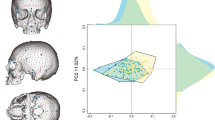Abstract
Crania are a reliable source for sex estimation in Euro-Americans, Europeans, and most other populations. Besides morphological assessments, the application of Fordisc® has become a useful tool within the last two decades, creating discriminant functions from morphometric data. Unfortunately, until now, white populations are mostly represented by measurements of American individuals. Therefore, classification rates are lower for European skulls than for Euro-Americans. The aim of this study was to show differences in sexual dimorphism between German and Euro-American crania. Furthermore, their secular change from the nineteenth to the twentieth century has been investigated. Analyses have been performed on glabella subtense (GLS), mastoid height (MDH), and bizygomatic breadth (ZYB). Fordisc® 3.1 was used to study sexual dimorphism and secular change, whereas SAS® was used to perform a two-level ANOVA to test for variation in sex dimorphism. Euro-Americans show greater dimorphism than Germans in all three measurements tested. This larger difference is even increasing from the late nineteenth through the late twentieth century in terms of GLS and MDH, while it stays almost the same in the present Europeans. These results explain the unsatisfying classification rates of German and other European crania on Fordisc®. Data collection for European Fordisc® samples is in progress and should improve the current situation.


Similar content being viewed by others
References
Walker PL (2008) Sexing skulls using discriminant function analysis of visually assessed traits. Am J Phys Anthropol 136:39–50
Ramsthaler F, Kreutz K, Verhoff MA (2007) Accuracy of metric sex analysis of skeletal remains using Fordisc based on a recent skull collection. Int J Legal Med 121(6):477–482
Komlos J, Lauderdale BE (2007) The mysterious trend in American heights in the 20th century. Am J Hum Biol 34(2):206–215
Ramsthaler F et al (2010) Digital forensic osteology: morphological sexing of skeletal remains using volume-rendered cranial CT scans. Forensic Sci Int 195(1-3):148–152
Fatah EEA et al (2014) Improving sex estimation from crania using a novel three-dimensional quantitative method. J Forensic Sci 59(3):590–600
Jantz RL, Ousley SD (2012) Introduction to Fordisc 3. In: Tersigni-Tarrant MA, Shirley NR (eds) Forensic anthropology: an introduction. CRC Press, Taylor and Francis Group, Boca Raton, pp 253–270
Guyomarc’h P, Bruzek J (2011) Accuracy and reliability in sex determination from skulls: a comparison of Fordisc® 3.0 and the discriminant function analysis. Forensic Sci Int 208:1–3
Alba RD, Golden RM (1986) Patterns of ethnic intermarriage in the United States. Soc Forces 65:202–223
Price AL et al (2008) Discerning the ancestry of European Americans in genetic association studies. PLoS Genet 4(1):e236
Ousley SD, McKeown AH (2001) Three dimensional digitizing of human skulls as an archival procedure. In: Williams E (ed) Human remains: conservation, retrieval and analysis. British Archaeological Reports, Oxford
Verhoff MA et al (2008) Digital forensic osteology—possibilities in cooperation with the Virtopsy® project. Forensic Sci Int 174(2-3):152–156
Franklin D et al (2013) Estimation of sex from cranial measurements in a Western Australian population. Forensic Sci Int 229(1-3):158.e1–158.e8
Howells WW (1973) Cranial variation in man: a study by multivariate analysis of patterns of difference among recent human populations, vol 67. Papers of the Peabody Museum of Archaeology and Ethnology, Harvard University, Cambridge
Spradley MK, Jantz RL (2011) Sex estimation in forensic anthropology: skull versus postcranial elements. J Forensic Sci 56(2):289–296
Konigsberg LK (1991) An historical note on the t-test for differences in sexual dimorphism between populations. Am J Phys Anthropol 84:93–96
Acsadi, G. and J. Nemeskeri (1970) History of human life span and mortality. Budapest Akadémiai Kiadó, Budapest
Cavalli-Sforza LL, Menozzi P, Piazza A (1994) The history and geography of human genes. Princeton University Press, Princeton
Seldin MF et al (2006) European population substructure: clustering of northern and southern populations. PLoS Genet 2(9):e143
Whitehouse AJO et al (2015) Prenatal testosterone exposure is related to sexually dimorphic facial morphology in adulthood. Proc R Soc B 282(1816):20151351
Fink B et al (2005) Second to fourth digit ratio and face shape. Proc R Soc B 272(1576):1995
Cieri RL et al (2014) Craniofacial feminization, social tolerance, and the origins of behavioral modernity. Curr Anthropol 55(4):419–443
Jantz, RL, L Meadows Jantz, and JL Devlin (2016), Secular changes in the postcranial skeleton of American whites. Human Biology. in press
Komlos J, M. B (2004) From the tallest to (one of) the fattest: the enigmatic fate of the American population in the 20th century. Econ Hum Biol 2:57–74
Jantz RL and L Meadows Jantz (2016) The remarkable change in Euro-American cranial shape and size. Human Biology. in press
Acknowledgments
The majority of analysis and writing of this paper was accomplished while the first author was a research scholar in the Department of Anthropology, University of Tennessee. She is grateful for the support of the Deutscher Akademischer Austauschdienst, which made the stay possible, and to the Department of Anthropology for accommodating her during that time. Furthermore, we would like to thank Dr. Birgit Großkopf, Thomas Struchholz, Helmuth Schlereth, Thomas Volk, Kevin Volk, Prof. Thomas Riepert, David Hunt, PhD, Douglas Owsley, PhD, Prof. Ursula Wittwer-Backofen, Katrin Koel-Abt, PhD, and Barbara Teßmann for providing skull material and Stephen D. Ousley, PhD and Taylor Yuzwa for collecting part of the German data.
Author information
Authors and Affiliations
Corresponding author
Rights and permissions
About this article
Cite this article
Manthey, L., Jantz, R.L., Bohnert, M. et al. Secular change of sexually dimorphic cranial variables in Euro-Americans and Germans. Int J Legal Med 131, 1113–1118 (2017). https://doi.org/10.1007/s00414-016-1469-2
Received:
Accepted:
Published:
Issue Date:
DOI: https://doi.org/10.1007/s00414-016-1469-2




